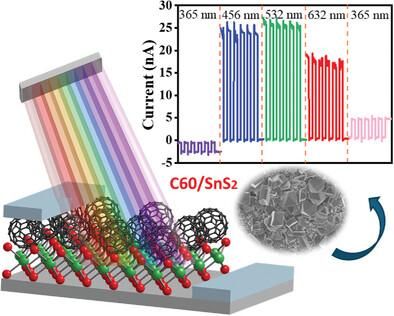Tunable Bi-directional Broadband Self-Powered Photoresponse in a 0D C60/2-D SnS2 Nanoflower Heterostructure
IF 13
2区 材料科学
Q1 CHEMISTRY, MULTIDISCIPLINARY
引用次数: 0
Abstract
Realizing bidirectional photodetection is essential for developing next-generation artificial neuromorphic systems, visual information processing, and future optoelectronic logic gates. Photodetectors are promising visible light communication systems due to their energy efficiency and cost-effectiveness. Color shift keying is frequently used in visible light communication to meet non-negative light intensity modulation demands. However, requiring a minimum of two photodetectors with filters to decode optical signals raises the device cost and complicates the communication system. Here, novel bidirectional photo response of 0-D C60/2-D SnS2 nanoflower heterostructure for self-powered broadband photodetector synthesis using sol–gel methods is presented. The photodetector exhibits significantly enhanced currents, with increases of ≈17000% (365 nm), 8750% (456 nm), 3333% (532 nm), 17647% (632 nm), and 124500% (850 nm) under zero bias, compared to C60. Furthermore, by adjusting the wavelength of the incident light, controllable bidirectional photoresponse (negative for wavelength = 365 nm and positive for 456–850 nm wavelengths) is achieved through the C60/SnS2, owing to the synergistic interplay between the photothermoelectric effect of C60 and the photovoltaic effect of SnS2. Polarity switching bestows multifunctional attributes upon photoelectric devices, potentially providing innovative approaches to overcome conventional challenges and fulfill the demands of emergent technological paradigms.

求助全文
约1分钟内获得全文
求助全文
来源期刊

Small
工程技术-材料科学:综合
CiteScore
17.70
自引率
3.80%
发文量
1830
审稿时长
2.1 months
期刊介绍:
Small serves as an exceptional platform for both experimental and theoretical studies in fundamental and applied interdisciplinary research at the nano- and microscale. The journal offers a compelling mix of peer-reviewed Research Articles, Reviews, Perspectives, and Comments.
With a remarkable 2022 Journal Impact Factor of 13.3 (Journal Citation Reports from Clarivate Analytics, 2023), Small remains among the top multidisciplinary journals, covering a wide range of topics at the interface of materials science, chemistry, physics, engineering, medicine, and biology.
Small's readership includes biochemists, biologists, biomedical scientists, chemists, engineers, information technologists, materials scientists, physicists, and theoreticians alike.
 求助内容:
求助内容: 应助结果提醒方式:
应助结果提醒方式:


